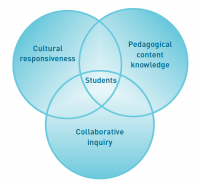Why focus on inquiry and on Māori and Pasifika student achievement?
How were these materials generated?
What do these materials consist of and how might you use them?
Reflective questions
Why focus on inquiry and Māori and Pasifika student achievement?
The New Zealand Curriculum and Te Marautanga o Aotearoa explain why an inquiry approach to teaching is so important.
Since any teaching strategy works differently in different contexts for different students, effective pedagogy requires that teachers inquire into the impact of their teaching on their students.
The New Zealand Curriculum, Ministry of Education, 2007, page 35
The New Zealand Curriculum describes a cyclical process of inquiry that it calls “Teaching as Inquiry”. The purpose of the Teaching as Inquiry cycle is to help students achieve worthwhile learning that will lead them to become “confident, connected, actively involved, and lifelong learners” (page 8).
It isn't just about student learning
While students are at its heart, the Teaching as Inquiry cycle isn’t just about student learning. It’s also about teacher learning. When teachers inquire into the relationship between their teaching and their students’ learning, they add to the knowledge and skills they can use to respond to the particular needs, interests, and strengths of the diverse students in their classes. As teachers build their knowledge and talk about their learning with their students, they model for their students what it is to be a lifelong learner.
Doing better for our Māori and Pasifika students
All those who work in education in Aotearoa New Zealand can take pride in the results we achieve for our young people. We can point to years of outcome-linked evidence showing that many of our young people are succeeding as learners. Nevertheless, we also know that, on average, some groups have not been learning successfully within our education system and that these groups have tended to include Māori and Pasifika. In the face of increasing evidence that these patterns are not set in stone and that effective teaching can make a real difference for all students, there has been a more deliberate focus on doing better for our Māori and Pasifika students.
Doing better for our Māori and Pasifika students requires recognising the rich diversity that exists within each of the two student populations. For example, New Zealand’s Pasifika population includes multiple ethnicities, languages, and cultures, and Pasifika communities comprise people born in the Pacific Islands and in New Zealand. Doing better also requires recognising that each student is an individual, with their own understanding of what it means to be Māori or Pasifika and of what it means to be a New Zealander.
Ka Hikitia: A strategy for success
Ka Hikitia calls for an approach that focuses on Māori potential. Ka Hikitia has three underlying principles:
- Māori potential: all Māori learners have unlimited potential
- Cultural advantage: all Māori have cultural advantage by virtue of who they are - being Māori is an asset; not a problem
- Inherent capability: all Māori are inherently capable of achieving success.
Ministry of Education, 2007a, page 19.
Like Ka Hikitia, the Pasifika Education Plan calls for the education system to “step up” so that Pasifika students gain the education they need for future success.
Success in education is positively harnessing Pasifika diversity and their multiple world views within an enabling education system that works for young people, their families and communities. These are the cornerstones of stepping up the Pasifika Education Plan to accelerate urgency in achieving better education outcomes for Pasifika. Pasifika success is critical for the future of Aotearoa New Zealand.
Pasifika Education Plan, Ministry of Education, 2007
Return to top
How were these materials generated?
These materials emerged as a consequence of the commitment of teachers from schools throughout Aotearoa New Zealand who took up the opportunity to participate in the Quality Teaching Research and Development Project (QTR&D).
QTR&D was an exploratory project founded on the beliefs that all young people can succeed at school and that one of the keys to enabling students to achieve their potential is effective classroom teaching. Its purpose was to help teachers improve teaching and learning outcomes for their Māori and Pasifika students by providing the teachers with opportunities to inquire into their classroom practice and to participate in tertiary study.
Who supported the project
University-based lecturers and facilitators provided support to the project in nine different “hubs” around the country. Each hub involved teachers working in a particular context (literacy, numeracy, social studies, or science) and a particular language setting (English medium, Māori medium, or Samoan bilingual). While all hubs shared the same basic principles and goals, the providers were able to design and implement courses that met the needs and built on the knowledge of particular groups of teachers.
A commitment to improving outcomes
Although the teachers who participated in QTR&D worked within a range of contexts, they shared a commitment to improving outcomes for their Māori and Pasifika students. They all had the opportunity to read and discuss research and recent literature on their inquiry question, to deliberately apply their new understandings within their classroom practice, and to evaluate the impact of doing so. Their learning goals were to:
- increase their pedagogical knowledge and skills in their particular curriculum area;
- explore culturally responsive pedagogies and how they could use them to enable their Māori and Pasifika students to achieve to their full potential;
- use Teaching as Inquiry processes to connect general principals about effective pedagogy to the diverse experiences, strengths, knowledge, and needs of the students they taught.
Students at the centre of the learning
The teachers placed students at the centre of their learning, which could be visualised like this:
Each of the teachers reported on their inquiry into their practice. Seven of these reports have been adapted as learning stories; these are included in this set of materials as springboards for thinking about the Teaching as Inquiry cycle, effective pedagogy, and cultural responsiveness and how they might connect to your own practice.
Most of the teachers in QTR&D did not use the Teaching as Inquiry cycle as illustrated in The New Zealand Curriculum (page 35), as it was still in development at the time. They used a variety of different inquiry approaches, all of which aimed to improve student outcomes through using evidence to solve problems.
The teachers’ stories have been mapped onto the Teaching as Inquiry cycle.
Return to top
What do these materials consist of and how might you use them?
There are a number of separate components to these materials:
- a printed brochure that includes this introduction, a section outlining and illustrating the Teaching as Inquiry cycle, and an overview of the learning stories;
- online learning stories or case studies that adopt the Teaching as Inquiry cycle to describe the work of seven of the teachers who participated in QTR&D.
The materials include reflective questions that are intended to trigger your thinking about the needs, strengths, and interests of the diverse students you teach. There are also links to related materials and websites that provide ready access to relevant content. You can use the stories, questions, and links to generate and seek answers to inquiry questions of your own.
The benefits of collaboration
While you could work through the materials by yourself, research shows that the most rewarding approach is likely to be to work with others with whom you can share and discuss ideas, questions, information, and experiences. Together, you can learn about your practice and, in the process, build a stronger knowledge base that will lead to significant improvements for your students.
Collaborative inquiry takes time and can be quite uncomfortable as participants encounter challenges to deeply held beliefs about teaching, about their students, and about themselves. Nevertheless, within your inquiry, even the smallest of changes may result in significant rewards that are an encouragement to carry on. This is reflected in the following quote written by one of the teachers at the end of her final report:
Thoughts shared: One participant's journey
This has been the beginning of a challenging but rewarding journey. I started by thinking I was aware of the issues and was meeting the needs of my Māori and Pasifika students pretty well.
Through exposure to research and new learning in the QTR&D project, I came to realise that my background and cultural perspectives had been influencing the effectiveness of my teaching for Māori and Pasifika students.
My journey of “learning, relearning and unlearning” had begun (Wink, 2000).
What was required seemed enormous, almost overwhelming, and my intervention seemed so small in comparison. I kept questioning whether I was really doing anything at all: would it make a difference, was it enough?
In the end, the students themselves answered these questions for me through their increased participation, excitement about learning, and deeper conceptual understandings. Even my small intervention made a big difference for my target students and me.
If my intervention made that much difference for my students, the possibilities to increase student participation and raise social studies conceptual understandings in the future are exciting and a challenge that I am eager to meet.
Return to top
Reflective questions
There are some important concepts and approaches that feature throughout these materials and that were, to different degrees, the focus of learning for teachers in QTR&D. They include cultural responsiveness, Teaching as Inquiry, effective pedagogy, evidence-based practice, and collaborative inquiry. As you work through these materials, you and your colleagues could ask yourselves:
- What are our shared understandings of these concepts and approaches? What informs our understandings?
- How much attention do we pay to these concepts and approaches at our school?
- How much attention do we pay to them in our teaching and learning practices?
Published on: 26 Aug 2009
Return to top


